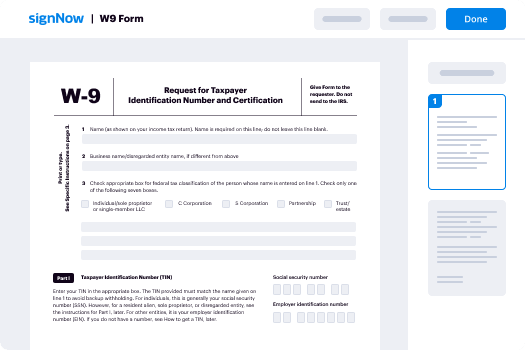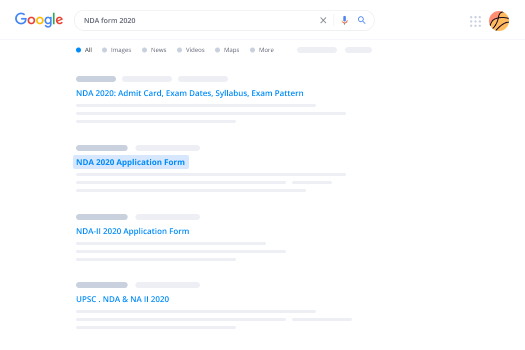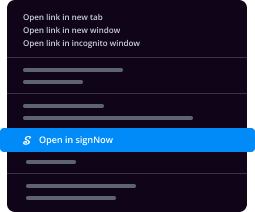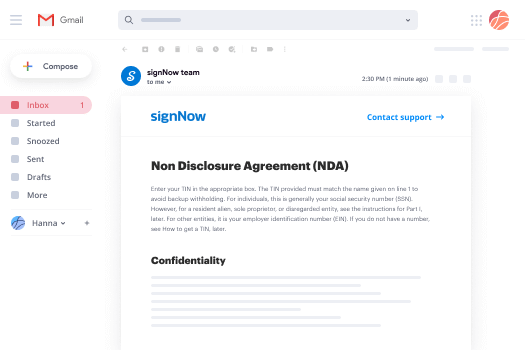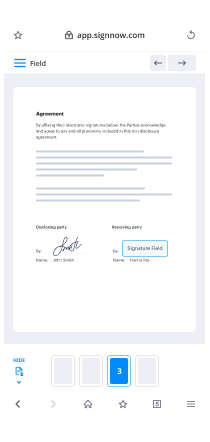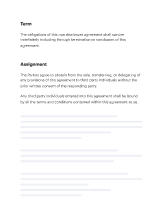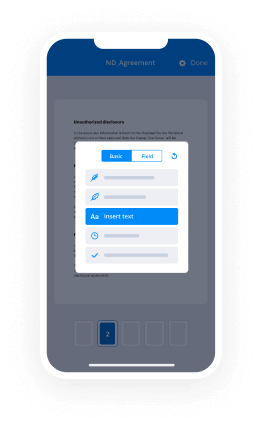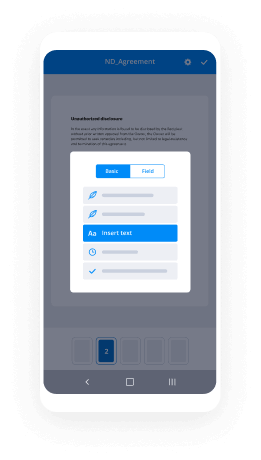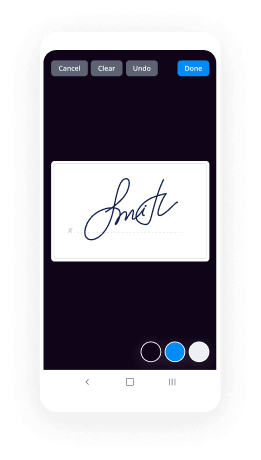Can I Sign Word
Make the most out of your eSignature workflows with airSlate SignNow
Extensive suite of eSignature tools
Robust integration and API capabilities
Advanced security and compliance
Various collaboration tools
Enjoyable and stress-free signing experience
Extensive support
Keep your eSignature workflows on track
Our user reviews speak for themselves






I word sign can assist in optimizing your document workflows
If you’re seeking a resolution to improve your document signing workflow, the airSlate SignNow platform is a remarkable option. This intuitive tool empowers organizations to effortlessly transmit and eSign documents, rendering it a budget-friendly choice for handling signNow paperwork. With its strong features and clear pricing, airSlate SignNow is tailored for small and medium-sized enterprises aiming to enhance productivity.
I word sign can streamline your document signing workflow
- Launch your web browser and go to the airSlate SignNow homepage.
- Create a no-cost trial account or log in if you're an existing user.
- Choose the document you wish to sign or circulate for signatures by uploading it.
- If you intend to use this document often, convert it into a template for subsequent use.
- Access your uploaded document to make necessary edits: add fillable fields or insert pertinent information.
- Sign your document and designate signature fields for your recipients.
- Click 'Continue' to set up and dispatch your eSignature invitation.
In summary, airSlate SignNow offers a robust solution that maximizes your return on investment with its extensive feature set. It is crafted to be user-friendly and adaptable, making it perfect for small and mid-market enterprises.
Prepared to optimize your document workflows? Register for airSlate SignNow today and enjoy exceptional support and clear pricing with no hidden charges!
How it works
Rate your experience
-
Best ROI. Our customers achieve an average 7x ROI within the first six months.
-
Scales with your use cases. From SMBs to mid-market, airSlate SignNow delivers results for businesses of all sizes.
-
Intuitive UI and API. Sign and send documents from your apps in minutes.
A smarter way to work: —how to industry sign banking integrate
FAQs
-
What does the i word sign can do for my business?
The i word sign can streamline your document signing process, allowing you to send and eSign documents quickly and efficiently. With airSlate SignNow, you can enhance productivity and reduce turnaround times, making it easier for your team to manage contracts and agreements.
-
How does the i word sign can improve document security?
The i word sign can signNowly improve document security through advanced encryption and secure storage. airSlate SignNow ensures that your sensitive information is protected during the signing process, giving you peace of mind while handling important documents.
-
What are the pricing options for the i word sign can?
The i word sign can offer flexible pricing plans to suit businesses of all sizes. airSlate SignNow provides a range of options, including monthly and annual subscriptions, allowing you to choose a plan that fits your budget and needs.
-
Is it easy to integrate the i word sign can with other software?
Yes, the i word sign can seamlessly integrate with various applications and software. airSlate SignNow offers integrations with popular tools like Google Workspace, Salesforce, and Microsoft Office, making it easy to incorporate eSigning into your existing workflows.
-
What features does the i word sign can include?
The i word sign can include features like customizable templates, automated reminders, and real-time tracking of document status. These functionalities help you manage your signing process more effectively, ensuring that you never miss a deadline.
-
Can the i word sign can help with compliance and legal standards?
Absolutely! The i word sign can assist your business in maintaining compliance with legal standards such as ESIGN and UETA. airSlate SignNow provides legally binding eSignatures that meet industry regulations, ensuring your documents are valid and enforceable.
-
What benefits can I expect from using the i word sign can?
Using the i word sign can provide numerous benefits, including time savings, reduced costs, and improved customer satisfaction. With airSlate SignNow, you can accelerate your signing process, allowing you to close deals faster and enhance your overall operational efficiency.
-
How can I sign a Word doc without printing it?
How can I sign a Word doc without printing it? From an absolute legalistic perspective, you probably can’t. But you can scan your signature and insert it in your doc. The ‘best’ way to do this (i.e. make it look real) is to begin with a very large signature. Take a full sheet of white paper in landscape orientation and scrawl your signature right across it, as big as possible. Use a big, thick permanent marker. (Black works best.) Now scan the result. At this point you can, if you’re worried about document size, scale the image of your signature down a bit … but not too much. You want a big sig with 600 horizontal pixels being the absolute minimum size. In Word, insert your signature via Insert -%3E Picture. Once you’ve done that, left-click anywhere on the signature. Then grab a corner with the left mouse button and scale (drag) the image down to a suitable size. Scaling down a large image helps hide speckling and aliasing, and makes the signature look much more real. By rights you should be able to scale down in a graphics package and simply import the resulting lower resolution signature image into Word. I do not know why, but this never seems to work as well (look as good) as doing the scaling in Word. Maybe it’s just me.
-
How can multiple parties sign Word or PDF docs I create using a stylus pen?
You can do this job through eSign+ platform. It’s an easy-to-use website that allows you to send PDF via email to multiple parties to sign it. You can draw, type and upload a signature.
-
If I sign a contract but the wording is different to my understanding which was agreed in emails can I dispute the contract or a
You’ve received some excellent answers here, including some from lawyers (who know far more about the law than I do). Still . . .If you sign a contract, the presumption is that you’ve read the contract. Your signature says you agree to its terms and conditions.There are plenty of times in which the wording may differ from what you understood the emails were saying. It may be that the language in the emails was “cleaned up” and rewritten. Possibly the contract still reflects the content of the emails, but just in “legalese.” Possibly the contract doesn’t reflect the content of the emails. That might have arisen through error. Or it might be intentional.Further, there are plenty of times in which items are negotiated in a variety of formats. Sure, you can send emails back and forth. But perhaps, after receiving one such email, you call the other party and negotiate/agree to something that’s different than what’s in the email. The contract as drafted reflects those additional conversations, not just the email.Bottom line: In nearly all cases, what you signed is what’s enforceable.Tip: If you believe that the disputed provision in the contract doesn’t reflect what you thought you’d agreed to, consult with either a lawyer or (more practically) contact the other party and explore that provision. If it turns out that the contract should have read the way you think—and the other party agrees—then have an addendum drafted and signed by both parties clarifying that provision.
-
Today I signed my resignation letter. They told me they were going to give me a recommendation letter and that I could return to
Since this is academia and not industry the rules are different. Generally in industry, once you resign there is no going back. However, for graduate school, people tend to be extremely liberal about people coming back, so if you left on reasonably good terms, it's not uncommon for a department to take you back if you've changed your mind.Also the fact that they are saying nice things about you, means that from their point of view you aren't leaving under a cloud.
-
How can I create a plus/minus sign in Word?
There are many methods for this:- METHOD 1: Use one of the above techniques, then set up an autocorrect to replace "+/-" with "±". That way you can just type it and it automatically appears. To set up Autocorrect: (in word 2013):- 1. Add a text entry to the AutoCorrect list 2. Click the File tab. 3. Click Options. 4. Click Proofing. 5. Click AutoCorrect Options. 6. On the AutoCorrect tab, make sure the Replace text as you type check box is selected. 7. In the Replace box, type "+/-" 8. In the With box, type "±" (cut and paste from a document where you used one of the previous methods) 9. Click Add. 10. Click OK. METHOD 2: 1. Run charmap. 2. Look for ±. 3. Select. 4. Copy. 5. Paste into Word. METHOD 3: 1. Hold down the ALT key while typing 241 from the 10-key number pad. METHOD 4: 1. Search plus/minus sign on Google. 2. Go to the first site or anyone you want. 3. Look for ±. 4. Select it. 5. Copy it. 6. Paste it. HOPE YOU FOUND THESE 4 METHODS USEFUL.
-
How do I learn to say no?
Saying "no" unskillfully nearly cost me my life. I was trained to be firm and calm; to repeat "no" as many times as necessary until the boundary was made clear. "No," they said, "is a complete sentence." One of the things we teach, in my job with court-mandated clients, is discipline, and one of the ways we do this is by enforcing punctuality. On a summer afternoon, 15 minutes into a process group, a young stranger threw open the door and walked in. He was short, maybe 5' 1, and pale. His pants hung low on his hips and, looking back, he was too confident for someone wearing a plaid golf cap too big for his head. I asked him to step outside with me - as was company policy - to explain how to attend a make-up activity and send him on his way. I was half standing when he said, "No. I'm staying." He was physically in front of the closed door. "You can come back next week, but I can't allow you to attend today." "You will let me attend today." "No, I can not." After several long minutes of back and forth I finally said. "I can't allow you to attend, but I am not going to physically force you out the door. You will be getting no credit for today. You need to leave." I sat back down with the group. "What's a situation in your life when someone wouldn't take 'no' for an answer?" I asked. After five more minutes of being ignored he left, and the group continued. An hour later the group was over and I was standing outside my office talking to a client. One of the group members came running down the hall, eyes wide. "Diane! Don't go outside! He's waiting for you in the parking lot with a gun!" Long story short, he didn't shoot me or anyone else. By the time the authorities arrived he was gone. When we realized he wasn't in my paperwork and the clients who reported him melted away at the mention of the police I started shaking so much I had to sit down. The officer taking the report said, "People like this make a couple mortal enemies every day. Lay low for a bit and he'll quickly forget you in his rage at the checker in the grocery store." I found this equally distressing and comforting. I went to visit my godparents in the mountains. I refused the gun they offered when it was time to go home. I got and still keep big dogs at my house. For the next several months I scanned the faces of the hundreds of clients I passed in the halls at work. He showed up occasionally in my dreams, or his hat did at least, because in my memory I still can't see his face. One of my friends makes me laugh when he says the state motto of Arizona is "An armed society is a polite society." So, all this to say, here's how I've learned to say no: "I wish...but..." * "I wish I could let you into group late, but the state law says we can't." * "I wish I could include your ideas in my next workshop, but the curriculum is already worked out." * "I wish that I could lend you $100, but I am short this month." When things are intense I add "and" to the mix. * "I wish I could have you stay on my couch, but my home is my refuge and I need my quiet time." * "I wish I could just let you in this one time, but the law is really clear and I'd lose my job." If it gets emotional or extreme, I load on validation and send them somewhere for more help. * I know, it's awful. You came a long way and the bus was late, and if I could I would SO break the rules for you. Maybe you can head up to the front office and see about setting up a make up group right after group next week." "No," some people say, "is a complete sentence." It is; it's just not always the best sentence for the job. Image: Plaid Golf Cap Hat [ http://www.etsy.com/listing/79960122/plaid-golf-cap-hat ]
-
How can I teach myself ASL using video tutorials when some words use different signs even though it's the same word?
I am learning ASL one on one from my fiancée, the lovely Rebecca who also answered this question for you but I've decided to add my experience as a hearing person learning ASL. I have the vocabulary of a demented toddler, never overstate your mastery of the language if you do seriously pursue learning ASL, the Deaf do not appreciate this and find it offensive, you won't make friends if you claim fluency you don't have. No the alphabet and fingerspelling English is not fluency, it is annoying and to be avoided in most cases.I often get signs backwards or not quite right when first shown them and she corrects me and we practice them until I get them correct. If I was mimicking a video I would not get the instant correction and not realize I was doing the mirror image thing and continue to be backwards. Nothing beats in person instruction for a language that is beyond not English. ASL is a visual language that is both not oral nor written, it is about as not English as you can get so you really can't treat it like you would learning any other foreign language that you could get away with teaching yourself at least the basics of. As the other answers have stated you will only learn which signs are appropriate to use in what context and region (regional dialects are more a thing in the Deaf community than in the hearing community) if you take local classes, preferably taught by people in or connected to your local Deaf community. Not only will they teach you proper ASL but you can also meet people within your local community and learn about Deaf culture and have people to talk to because what is the point of learning ASL if you have no one to talk to?
Trusted esignature solution— what our customers are saying
Get legally-binding signatures now!
Related searches to Can I Sign Word
Frequently asked questions
How do i add an electronic signature to a word document?
How to use electronic signature paint?
How to electronically sign real estate documents?
Get more for Can I Sign Word
- Sign Massachusetts Banking Purchase Order Template Myself
- Sign Maine Banking Operating Agreement Computer
- Sign Banking PPT Minnesota Computer
- How To Sign Michigan Banking Living Will
- Sign Michigan Banking Moving Checklist Mobile
- Sign Maine Banking Limited Power Of Attorney Simple
- Sign Michigan Banking Moving Checklist Free
- Sign Montana Banking RFP Easy
Find out other sign can word i
- Iiitd smartphone fingerphoto database v1 ispfdv1 form
- Eu1 form 407258976
- Download form 42a806 formupack
- Harris stowe state university transcript request 80470042 form
- Newspaper article template for students form
- Orefonline form
- F8 chiropractic follow up re exam first health associates form
- Status conference agreement form new haven jd connecticut jud state ct
- Wcab forms
- Amazon new hire checklist form
- Annual leave form pdf
- Engineering notebook paper pdf form
- Rslb form
- Amm school full form
- Electronic funds transfer eft form 470 4202 iowa department ime state ia
- Hira foundation form
- Irp form 1 and 4
- Subjective peripheral neuropathy screen questionnaire reseauconceptuel umontreal form
- Affidavit for gap period form
- As 2067 download form










